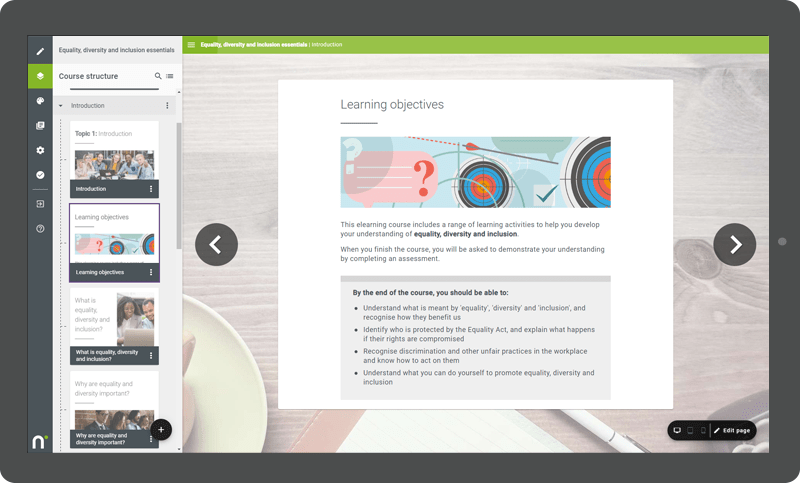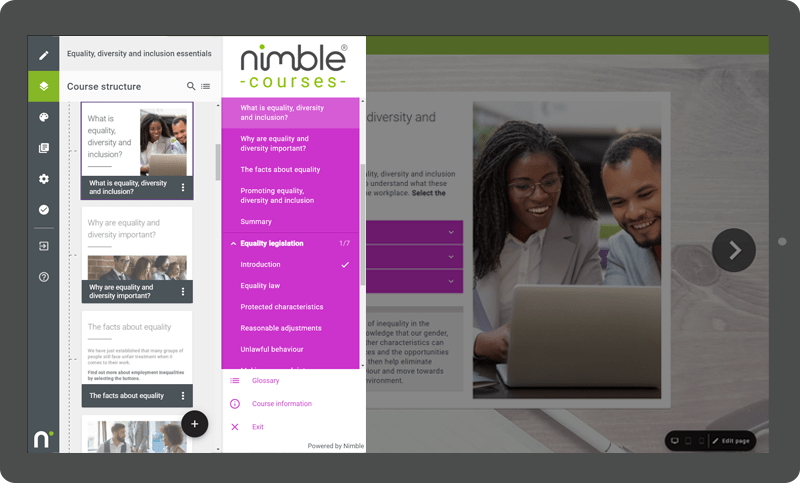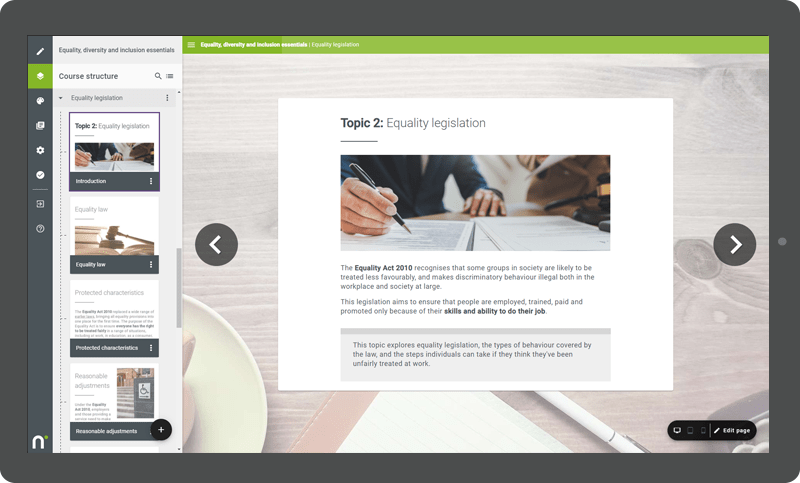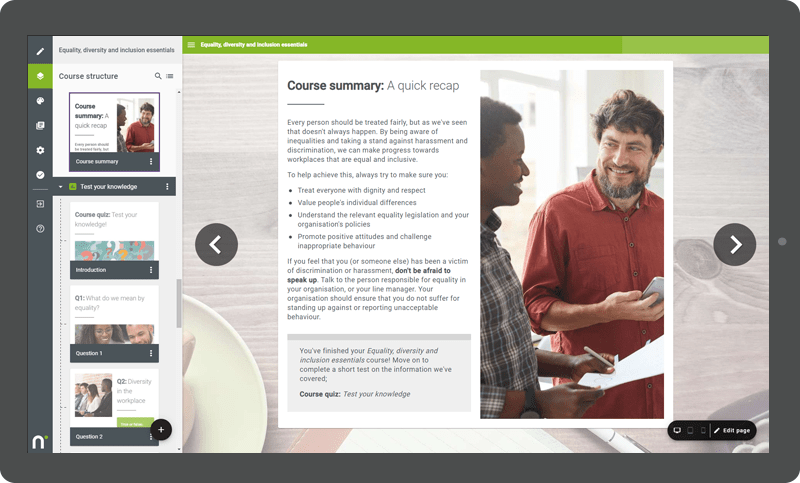It can be difficult to know where to start when planning the structure of an elearning course. Maybe you have a face-to-face course that you’d like to convert into an online offering, or you’re realising that your set of training PowerPoints isn’t going to cut it any more. Or perhaps you’ve designed a few elearning courses but feel you could do with a more organised approach to presenting the information. To help you find the best way to structure your elearning course for success, we’ll take a look at some of the common techniques you can use to make online learning effective and easy to follow.
You could take a more traditional approach and build a complex storyboard, but here we’re focusing on using a rapid authoring tool (such as Nimble Author) to structure your content from the ground up. This can be a great (and quick!) option, particularly if you have existing learning materials that you’d like to present in an elearning format and don’t have extensive experience using more complex authoring software.
There are no hard-and-fast rules, and as you gain more experience and confidence you’ll find new ways to present learning content that push boundaries. With that in mind, here are a few tips to help you evaluate the effectiveness of your course structure.
Setting off on the right foot

Welcome page
You’ll definitely want to include a welcome page at the beginning of your course. It sets the tone for the rest of the learning experience, and is a good opportunity to get learners on board and engaged with the content. A great place to start is with an image that gets across the theme of your course and piques people’s interest. Don’t forget to include the purpose of the course: why should your learner be interested, and what benefits will this learning experience give them? If your course is designed to improve workplace performance, make sure you bring it back to the impact on your learner’s role and personal development.
Learning objectives
Learning objectives do two important jobs:
- They tell the learner what they can expect to master by the end
- The process of writing them also makes you – the course designer – think carefully about exactly what the course is for
Don’t underestimate the second point! If you’re writing an online course, it’s because you’ve identified a knowledge or skills gap that needs to be bridged. Keeping that in mind as you design the learning structure is of critical importance if you want your course to be a success.
When you’re writing learning objectives, it’s helpful to think about using action words that get across what your learners should be able to do at the end of the course. Even better, get right to the heart of how they’ll apply this knowledge on the job. Here are some good examples:
- Identify a transaction that is likely to be fraudulent
- Administer a flu vaccine safely
- Apply practical strategies to reduce your stress level at work
- Build the perfect mozzarella and tomato ciabatta
- Defuse a difficult customer conversation
Picking your sequence

Choosing the right order for the content in your course is critical, but often overlooked. Sometimes, it’s obvious how you should sequence your learning material: looking at some of the learning objectives above for inspiration, you’re likely to organise the Making An Awesome Ciabatta course by the steps in the process of building a tasty sandwich.
But not all content comes with an in-built sequence. Sometimes, you might want to present an overview of the whole topic first, then dive deeper into the component parts. In other cases, you could consider taking the opposite approach: start with bite-sized pieces of knowledge that give your learner the foundation they need to understand the big picture, then bring it all together at the end. There are as many ways to sequence a course as there are things to learn about! Just make sure you devote some time to planning a logical progression for your specific learning experience.
Using topics

Unless your course is very short and simple, it’s a good idea to organise the content into topics or sections. This allows you to break information down into smaller chunks.
Introductions and summaries for each topic
It’s a good idea to signpost what you’ll be covering in a topic with a short introduction, and then summarise it at the end of the topic. This strategy gives your learners a clear idea of what they’ll be expected to know once they’ve completed the course, but it also helps to reinforce learning through repetition. Summaries in particular are a great place to relate the information to your learners’ day-to-day roles. Cementing the concepts in bite-sized format – but also providing an opportunity to apply it to the world of work – is a great way to wrap up a topic so that it resonates with your learners.
Writing useful headings
Within your topic, you’ll have a number of pages – and headings are a great way to let your learners know what you’re covering. Unfortunately, headings can often be inconsistent, unclear or, at their worst, meaningless. Try following these tips as a guide:
- Keep headings short (a single line) and consistent; choose a rule for capitalisation and stick to it!
- Make headings relevant. ‘Page Five’ or ‘Case Study Two’ aren’t giving your learners any information about what they’re learning, and they’re unlikely to help make your content stick
- Remember that your headings act as a navigational aid when learners are browsing through the structure – so make sure they’re useful!
For more ideas about how to make your elearning course easy to navigate and appealing to the senses, take a look at our articles about using images to maximise learning and making elearning visually engaging.
Wrapping it up

Summary and review of what’s been learnt
Just like with topic introductions and summaries, it’s important to revisit what you’ve covered across the whole course. Make sure you come back to the learning objectives at this stage. Learners should have an opportunity to think back to their aims when starting the course, and reflect on whether or not they’ve achieved them.
Assessment
Most elearning courses include a short assessment near the end, and with good reason; not only does it give you the opportunity to find out if your learners have understood the material, it actually also helps them to encode into their memory to access later. Unless your course is very long and in-depth, you’ll probably want to include about ten questions that span the included topics. Wording questions carefully is very important, and a lot harder than it seems! It’s definitely worth investing the time in writing and reviewing your assessment so that it provides a useful benchmark of learner progress, and reflects the learning objectives of your course.
If you want to take your approach to assessment to the next level, you might be interested in our article about using testing in your elearning courses.
Survey
The final element to many elearning courses is a survey, which can have a few different benefits for you as an elearning author. Depending on the focus of your survey questions, you can collect some useful data:
- Did people enjoy the course?
- What was the best part?
- Did they find it useful?
- Can they see how what they learnt will be relevant for their role?
- Do they have any suggestions for improvement?
Carefully-worded questions can provide you with insightful comments and a great overview of how your learners got on. Combined with course completion data and assessment results, this information can be a good starting point for evaluating the impact of your course. To dig a little deeper, check out our article about using data for success in L&D.
When you’re faced with the task of writing a whole elearning course, it can seem overwhelming at first. Sketching out a basic structure is a great place to start, and with a few simple principles to follow you’ll soon find your course taking shape. As with any skill, practice makes perfect – but before you know it, you’ll be structuring your elearning courses for success.


0 Comments